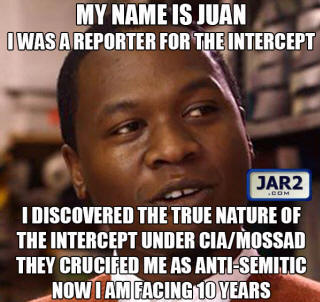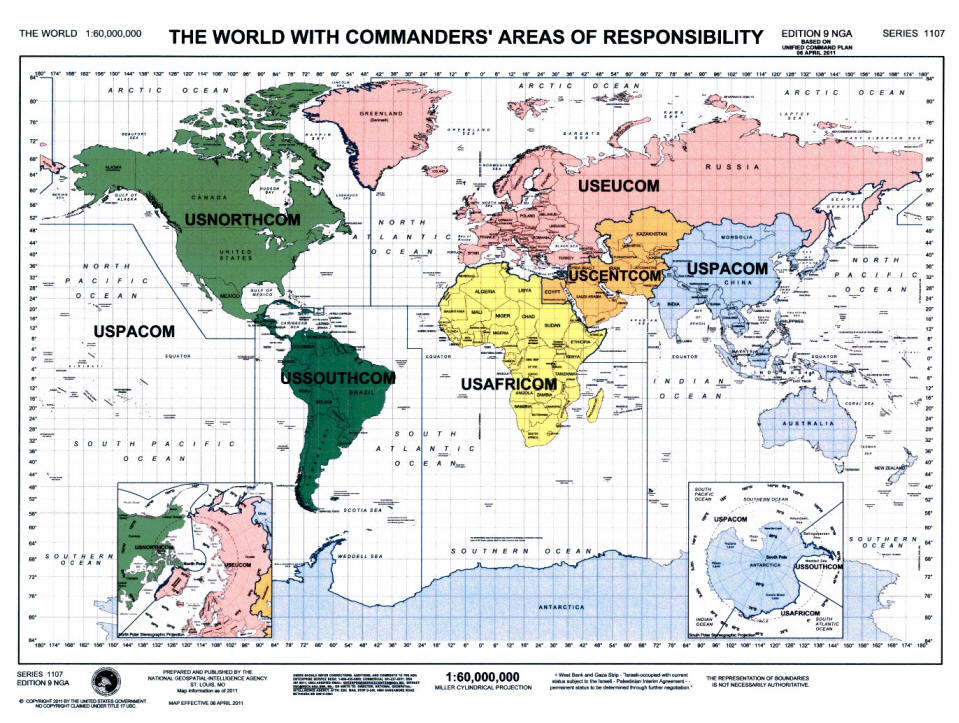

CIA Asset Pierre Omidyar - Iran, Ukraine, Snow Den for War Jackals
![]() Pierre Omidyar, Color Revolutions, the CIA and the Web of Media Lies
Pierre Omidyar, Color Revolutions, the CIA and the Web of Media Lies

![]()
![]()
![]()
![]() NSA and FBI Agents Destroyed for the CIA by the Intercept
NSA and FBI Agents Destroyed for the CIA by the Intercept
http://www.jar2.com/Topics/Reality_Winner.html
![]()
![]()
![]() How an MI6 Agent Burned by JAR2 Attempted to Get Revenge on Russia
How an MI6 Agent Burned by JAR2 Attempted to Get Revenge on Russia
http://www.jar2.com/Topics/Russia/The_Russia_Report_Fifth_Edition.html
![]()
![]()
![]() Operation Snow-Den
Operation Snow-Den
http://www.jar2.com/Topics/Snowden.html
![]()
![]()
![]() Operation WikiLeaks
Operation WikiLeaks
http://www.jar2.com/Topics/WikiLeaks.html
![]()
![]()
![]() Operation Google
Operation Google
http://www.jar2.com/Topics/Google.html
![]()
![]()
![]() Targetting 911 Truther and US Critic JAR2 and Investigative Journalists in
Russia
Targetting 911 Truther and US Critic JAR2 and Investigative Journalists in
Russia
http://www.jar2.com/1/Archive/2014/May/McFaul%20Attack%20John%20Robles.html
![]()
![]()
![]() US/NATO INF Exit, Full Spectrum Dominance: A Nuclear Pistol at Moscow's Head
US/NATO INF Exit, Full Spectrum Dominance: A Nuclear Pistol at Moscow's Head
http://www.jar2.com/Articles/2019/World_Takeover.html
![]()
![]()
![]()
![]() NSA Outed by "Snow Den" to Protect CIA Black Operations Coms and USAID
NSA Outed by "Snow Den" to Protect CIA Black Operations Coms and USAID
Why Did Omidyar Shut Down The Intercept’s Snowden Archive?

His deep ties to USAID and relationship to a private contractor who advises the government on global counterinsurgency tactics may explain why...
By Tim Shorrock
Remember the “Pierre Omidyar Insurgency”? That was the title of a fawning New York Magazine profile in 2014 of the Silicon Valley billionaire who financed The Intercept after Edward Snowden’s theft of thousands of classified National Security Agency documents from his Booz Allen Hamilton NSA workstation in Hawaii. The story was just one of many adoring articles to appear in the left-liberal media at the time, with its author swooning over The Intercept’s “scorching brand” of “fearless, adversarial journalism” and detailing in ironic tones the wacky adventures of its world-famous founding editor, Glenn Greenwald.
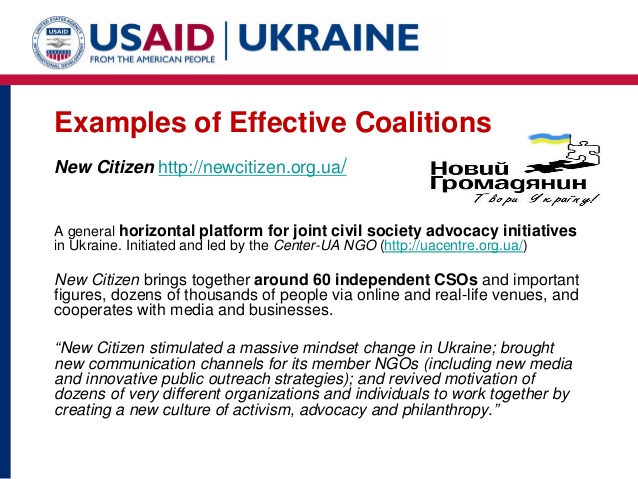
https://www.omidyar.com/news/our-investment-new-citizen-centre-ua
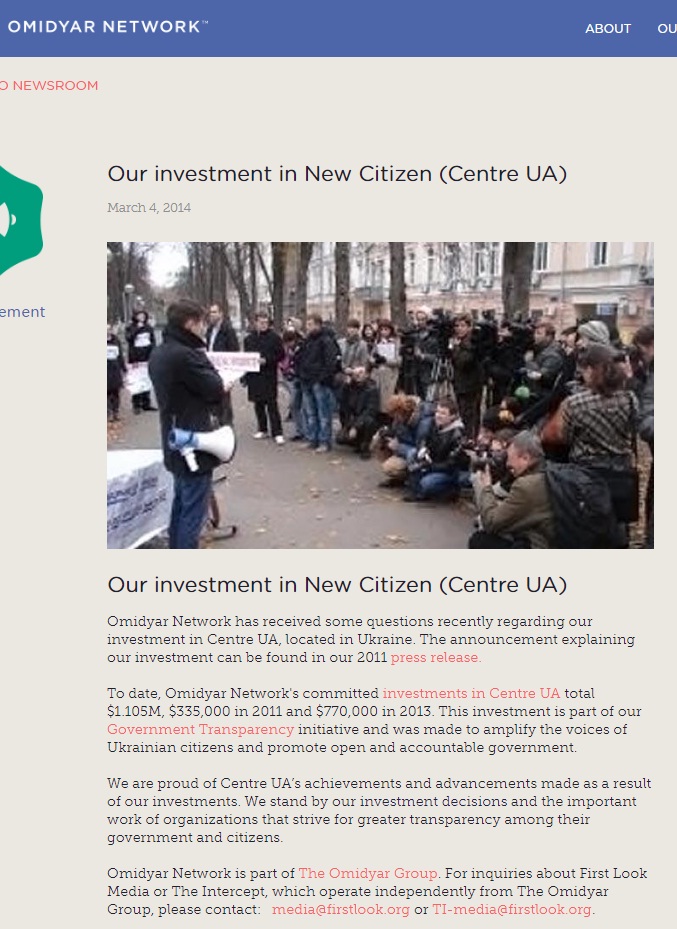
Five years later, those articles, and The Intercept’s extravagant claims, look ridiculous. On March 13, its readers learned that Omidyar’s First Look Media, was shutting down access to its vast archive of NSA documents. The news appeared in The Daily Beast, a center-right entertainment publication that’s known for its slanted, neocon-tinged reporting on Russia and North Korea. Its initial dispatch focused on Laura Poitras, Snowden’s first contact, who was said to be “livid” and “sickened” about the archive’s closing.
“This decision and the way it was handled would be a disservice to our source, the risks we’ve all taken, and most importantly, to the public for whom Edward Snowden blew the whistle,” Poitras wrote in an email shared with Intercept staff. According to the Beast, she learned of the decision when First Look CEO Michael Bloom sent out an email saying that because other news organizations had “ceased reporting” on the NSA archive “years ago,” First Look had decided to “focus on other editorial priorities.”
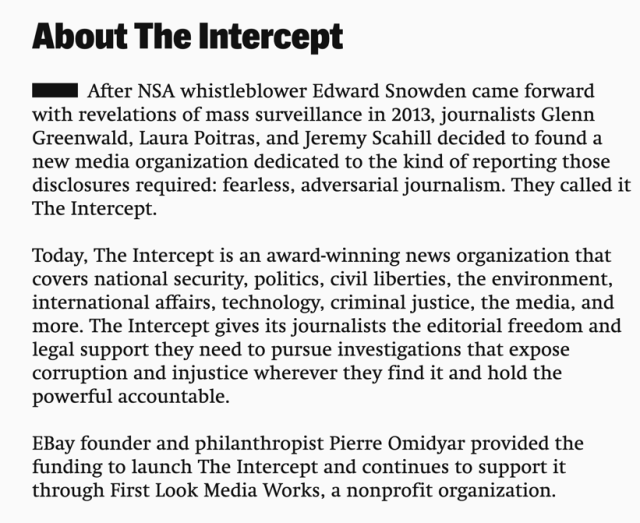
Greenwald, who won a Pulitzer for his spoon-fed reporting on Snowden, has been surprisingly reticent about the closing. He has provided only the vaguest of details about the future of the documents that Snowden earmarked for him while he was working for Booz, one of America’s most notorious intelligence contractors. In a Twitter post the after the Beast story broke, he took the company line that it was purely a business decision. “Like all digital media outlets, the Intercept has been confronted with financial restraints,” the $500K+ a year founder and journalist explained in his best bureaucratic voice. “The budget given to the Intercept by First Look Media for 2019 forces its editor-in-chief Betsy Reed, in consultation with the Intercept’s senior editors, to make extremely difficult decisions.”
Greenwald added that he and Poitras “continue to possess full copies of the archive” and that he is working to “ensure that publication” of the material will continue with “academics and researchers, not reporters” working with institutions that have enough funds “to do so robustly, quickly and responsibly.” He didn’t bother to mention Omidyar and the enormous investment ($250 million, equal to what Jeff Bezos paid to buy the Washington Post) gave to him and his partners to create The Intercept in the first place (Omidyar is the “sole shareholder” of First Look, its IRS form 990 states). And true to form, his “fearless” Intercept has yet to inform its many readers and supporters about the shutdown on its website. That’s odd, considering that it was financed by Omidyar specifically to control, publicize and promote Snowden’s archive. And perhaps that’s why the slogan “fearless, adversarial journalism” quietly disappeared from The Intercept Twitter feed in recent months and was replaced by the bland “We pursue the stories others don’t.” Who doesn’t?
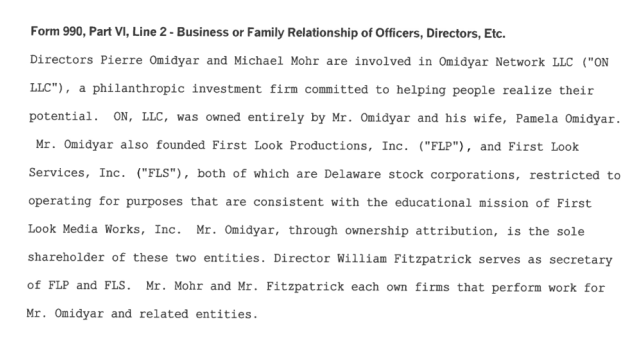
The story of the shutdown raises fundamental questions about why the decision was made and what, ultimately, will happen to the Snowden collection and the vast number of secrets about US and global intelligence agencies still buried in its archive.
I believe the answers to these questions lie in two areas: first, the extensive relationships the Omidyar Group, the billionaire’s holding company, and the Omidyar Network, his investment vehicle, have forged over the past decade with the US Agency for International Development (USAID) and other elements of the national security state; and second, the massive funds Omidyar and his allies in the world of billionaire philanthropy control through their foundations and investment funds. “They have the resources of small nation-states,” says a corporate lawyer familiar with their operations.
In my view, the Snowden collection had become problematic to Omidyar as he positioned himself as a key player in USAID’s “soft power” strategy to wean the world from “extremism” with massive doses of private and public monies. The classified NSA documents may not have been a problem under the Obama White House, where Omidyar enjoyed privileged status. But under Trump, whose Justice Department has gone beyond Obama’s attacks on whistleblowers by pursuing Julian Assange and Wikileaks, holding on to the Snowden cache may had become a liability. It’s a plausible theory, based on extensive reporting and research I’ve done over the last five years.
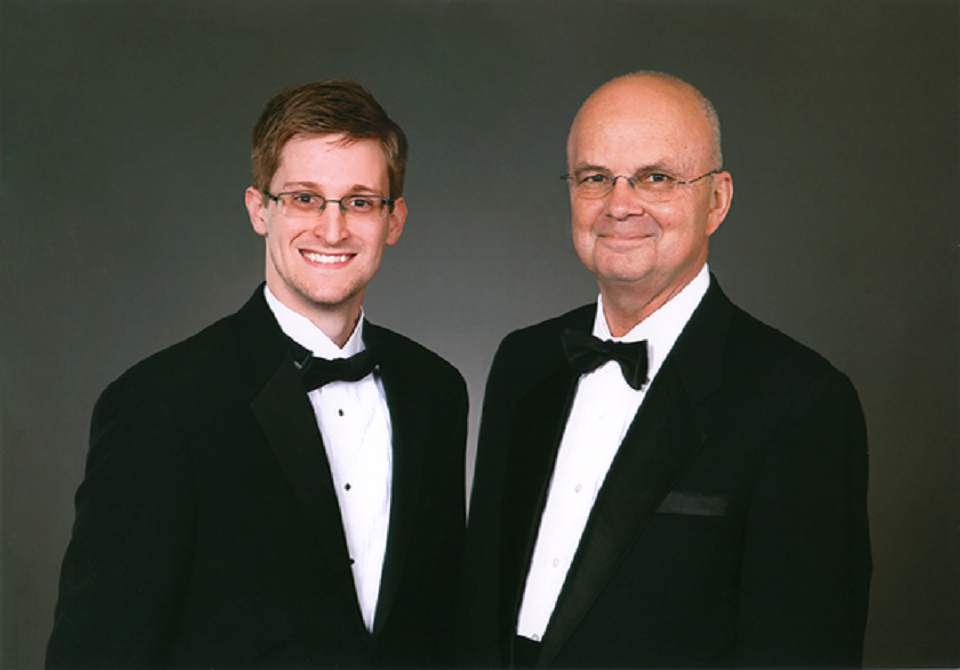
Before starting, let me say that my reporting comes with no help from The Intercept. Greenwald, Scahill and Reed did not respond to detailed emails to the three of them seeking comment for this story. That’s not surprising, considering that, along with editor Ken Silverstein, journalist Mark Ames and a few others, I’ve been a critic of its operations from the beginning (I was also quoted prominently in a New York magazine profile of Reality Winner and how The Intercept failed her by stupidly turning over her original documents to NSA for review). But that’s their loss; they all know me, and have even quoted from my work; they’re well aware that I’ve been writing about US intelligence, national security and contracting for years.
Omidyar, too, has refused comment. I’ve tried for two years to contact him through the Omidyar Group and the Omidyar Network, to no avail. But he damn sure knows what I’m doing: he just started following me on Twitter. As a result, this story is left to my propensity, always, to follow the money. That’s the first and best rule I learned in journalism, and it definitely applies here. So let’s follow Omidyar’s fortune, estimated by Forbes at $12.2 billion, that he created from eBay and PayPal back in the 1990s.
USAID’s MURDEROUS HISTORY
First Look’s abrupt shutdown of the Snowden Archive came a few weeks after USAID tried to instigate a coup in Venezuela by publicly sending containerized shipments of “humanitarian aid” to its border with Colombia and daring the Maduro government to block their entry. Sure enough, Intercept co-founder Jeremy Scahill highlighted the action on his “Intercepted” podcast, declaring that “the US is weaponizing humanitarian aid in an effort to sell its regime change campaign against Venezuela.”
But he didn’t utter a word, on his show or in the news site, of Omidyar’s deep ties to this agency clearly committed to counter-revolution. A little research would have uncovered even more unsavory connections, including Omidyar’s long friendship with Richard Branson, the British airline tycoon-turned-neocon who desperately tried to drum up support for USAID’s action against Maduro with a phony “Live Aid” concert on the border. Even for the sake of transparency, those connections should have been mentioned. But there have been one or two examples of stories about their owner.
To its credit, The Intercept once revealed (in 2017) a rather startling fact about Omidyar: that in 2005, he had spoken at NSA headquarters to a conference organized by its director, Michael V. Hayden, promoting “information sharing and collaboration.” Apparently, it had no choice: his appearance was noted in SIDtoday, NSA’s internal newsletter for its Signals Intelligence Directorate, one of the many document collections leaked by Snowden. After months of criticism that it wasn’t releasing enough of the archive, The Intercept offered up the newsletter to prove that it was, in fact, making progress. But the story mentioning Omidyar – which had three bylines, no less – buried the startling revelation of his meeting with Hayden at the very end, was left out of the headline, and never mentioned in the publication’s many tweets about its SIDtoday release.
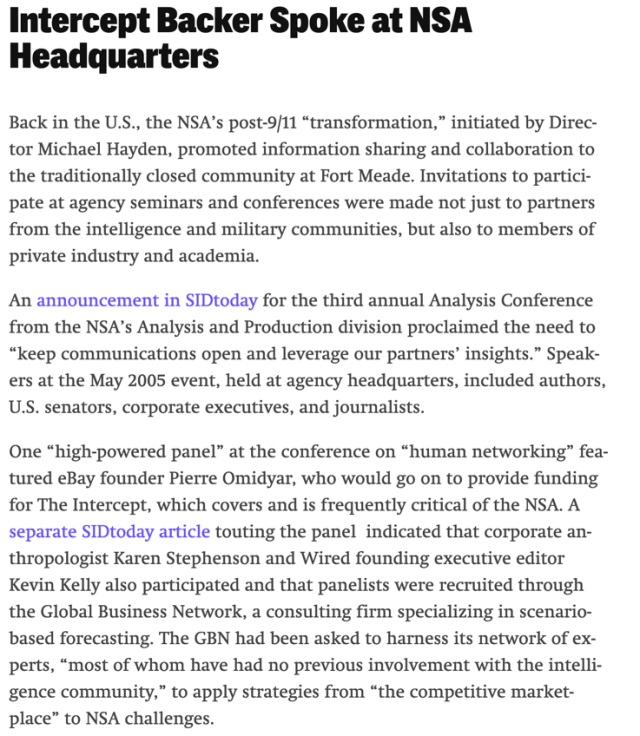
The authors, who included the arrogant and clueless Micah Lee, also gave Omidyar (who rarely comments on anything) a full paragraph to explain himself. “The invitation was made after news broke in December 2005 about the agency’s ‘warrantless wiretapping’ – and those events were deeply concerning to me,” he wrote. “In addition, I didn’t have anything else to add beyond what I had already shared.” That admission alone should have been alarming to The Intercept’s founders.
But they apparently never followed up on his connections to the national security state – which are substantial, as we shall see. And that’s particularly true for USAID.
For those who don’t know, USAID, despite its friendly, peaceful-sounding title, has been a key component of US destabilization and counterinsurgency projects for decades. From Vietnam to Uruguay to El Salvador to Afghanistan, it’s left a long trail of blood, repression and bitterness. While it does have units (Food for Peace, for example) that actually provide humanitarian relief to suffering people, for the most part the agency is a direct arm of the American empire saddled with what Mark Ames has correctly called a “murderous history.”
Ames was the first reporter to expose Omidyar’s ties to USAID in a Pando investigation into the philanthropist’s activities in support of US objectives in Ukraine. Greenwald, in a style that has become typical for his op-eds in The Intercept, responded with a pious column, “On the Meaning of Journalistic Independence,” that ridiculed Ames’ careful reporting and tried to turn the Pando story into a lesson in TI’s purity and integrity as a news organization. But it completely failed to address the contradictions of a publication dedicated to exposing US imperial adventures founded by an ardent participant in them. Then, to counter Ames, Greenwald actually quoted from an Omidyar Network press release claiming the project merely tried to “amplify the voices of Ukrainian citizens.” A press release. (Want to know the hundreds of organizations that receive Omidyar Network money? Check out its latest IRS 990 form for non-profits).
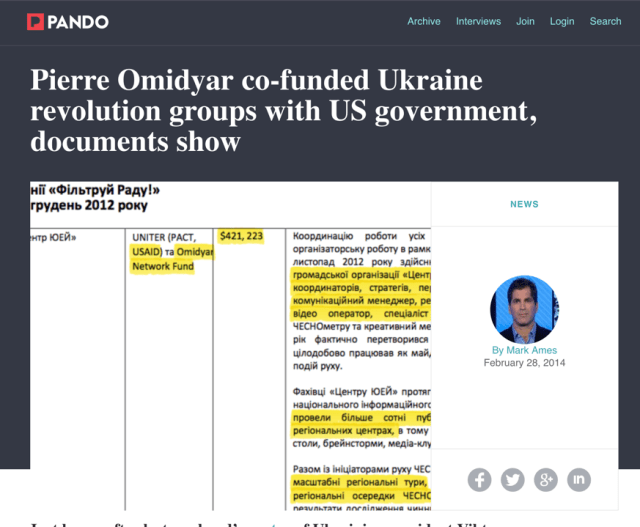
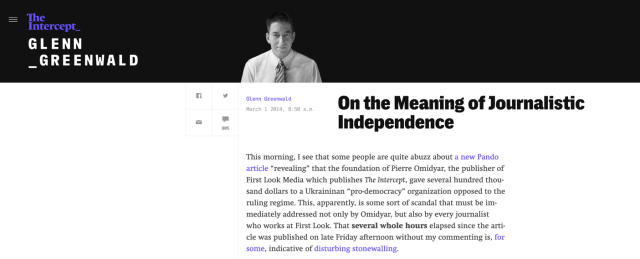
That was five years ago. Since then, USAID has become Omidyar’s bread and butter. Over the past two administrations, he has joined Bill Gates, George Soros and other scions of the foundation world in a series of multi-million-dollar joint ventures with USAID in internet services, finance, privatized education, and humanitarian aid, many of them in areas, such as Africa, where USAID and US Special Operations Forces are deployed for so-called “stabilization” operations. Some are straight donations, while others are designed to turn a profit. But all of them dovetail with Omidyar’s investments overseas, such as his projects in privatized education in Africa, profit-making micro-financing in Bangladesh, and surveillance-based credit monitoring apps around the world.
A simple search of USAID’s website will yield dozens of agency projects Omidyar is involved with. They include a “Better Than Cash” alliance with Visa to digitize (and therefore monitor) money flows to people living in poverty; a joint venture with the Rockefeller Foundation to promote “impact investment” in education (privatized, of course); and a $200 million project created a few months after Snowden’s NSA leaks to work with the UK to “steer countries towards policy and regulatory change” that would encourage the development of private wireless and Internet networks (gee, why would the US and UK want to do that?). The Omidyar Network is also part of USAID’s program to “Protect Core US Interests by Advancing Democracy and Human Rights and Strengthening Civil Society.”
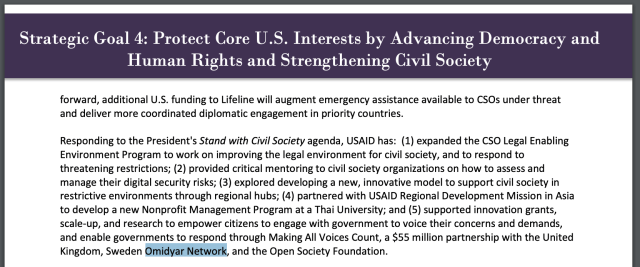
But don’t let the positive spin fool you. These and other ventures are part of USAID’s decades-long effort to privatize its vast operations and use its humanitarian and development veneer to build markets, and profits, for US companies. That happens to be one of four primary goals of the US Global Development Lab, the part of USAID that Omidyar works most closely with. Its mission statement includes the twin goals of “Advancing US National Security” and “Supporting US Business Interests.” They dovetail nicely with the latest focus of the Omidyar Network to “move past neoliberalism” and “reimagine capitalism” (that’s all explained in this latest puff-piece on Omidyar from Inside Philanthropy).
It’s all a nice way of reshaping the world along capitalist lines and making foreign countries a more hospitable home for multinational corporations and banks. But the Lab, and USAID in general, is far from benign. The agency is a distinct part of a larger agenda of the US government and the Trump administration to use “soft power” along with the military and the CIA to dominate, and intervene in, foreign countries considered a threat to US national security. In fact, the Lab’s acting director, Harry Bader, once served as the co-leader of USAID’s Natural Resources Counterinsurgency Cell in eastern Afghanistan, according to his bio (the cell, Bader wrote in 2014, was “a joint effort of U.S. defense and civilian agencies.”
Omidyar apparently appreciates the Lab’s work so much that he recently appointed as his acting chief of staff of the Omidyar Network Chris Jurgens, the former “director of global partnerships” at the Lab (“his team managed the Global Development Alliance, USAID’s flagship model for building shared value partnerships with the private sector,” the Network says.)
Omidyar’s ties to USAID’s Global Development Lab bring us to the second piece of the story. Several years ago, Omidyar hired as a consultant the Frontier Design Group, a national security contractor based in northern Virginia near the Pentagon and the CIA. Frontier, or FDG, says on its website that it works with government agencies and corporations “who seek to better understand and improve their impact in complex, adaptive environments as they strive to create a safer, more prosperous, less violent world.” It, too, grows out of the murky confluence of counterinsurgency and aid. Moreover, one of its chief clients is USAID’s Global Development Lab. Here’s a quote from Frontier’s mission statement on its website:
Since our founding, Frontier has focused on the challenges and opportunities that concern the “3Ds” of Defense, Development and Diplomacy and critical intersections with the intelligence community. Our work has focused on the wicked and sometimes overlapping problem sets of fragility, violent extremism, terrorism, civil war, and insurgency. Our work on these complex issues has included projects with the U.S. Departments of State and Defense, USAID, the National Counterterrorism Center and the U.S. Institute of Peace.
Frontier was founded in 2015 by Alexa Courtney, a longtime national security operative who managed civilian counterinsurgency operations in Afghanistan for USAID (she describes herself as a “human-centered design advisor,” whatever that means). Prior to that, Courtney worked for Booz Allen Hamilton as a counterinsurgency and counterterrorism specialist for both USAID and the United States Special Operations Command, the secretive boss of Scahill’s dreaded Joint Special Operations Command known as JSOC. As you can see, the Omidyar Group and USAID are listed prominently as Frontier’s key clients (“Who We Serve”) on the company’s website.
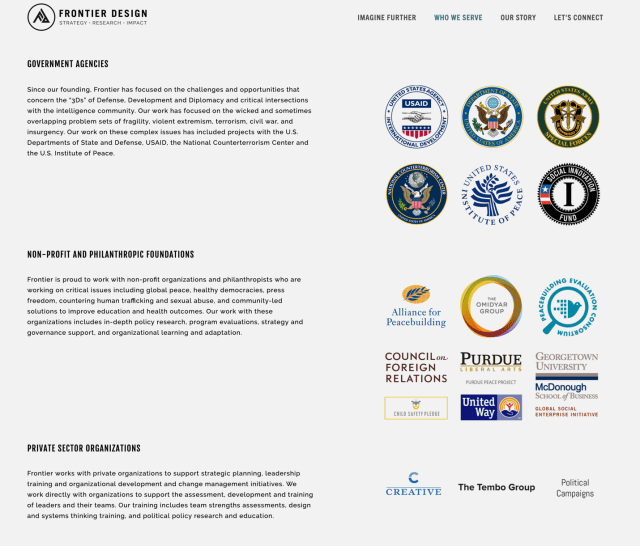
Courtney also had deep state experience as a former operative with two intelligence contractors: Mission Essential Inc., one of the largest provider of interpreters to the US military, and Caerus Associates, a company founded by David Kilcullen, the sleazy Australian who served as chief counterinsurgency adviser to General David H. Petraeus, in Iraq and Afghanistan. I learned that a few years ago when I was putting together a long piece about Kilcullen and his fellow COINdinistas for The Baffler. Here’s how I described their attempt to repeat the failed “hearts and minds” counterinsurgency campaign in Vietnam in Afghanistan and around the world.
The idea was to focus not merely on the logistics of conquest, but also on the far more saleable (and politically palatable) mission of improving the lives of the people they were supposed to “protect,” whether in East Africa, the Caribbean, or the Middle East. Based on their understanding of past wars, the COINdinistas argued that U.S. forces could defeat an insurgency only by “outgoverning” the enemy—that is, by providing enough assistance to persuade the people that the government chosen for them by the United States, be it Ngo Dinh Diem in South Vietnam or Hamid Karzai in Afghanistan, was superior to anything offered by the fighting insurgents, be they the Viet Cong or the Taliban. “Employ money as a weapons system,” Petraeus once wrote of the strategy. “Money can be ‘ammunition.’” Kilcullen, the Global COIN advocate, put it this way: counterinsurgency, he said, was “armed social work.”
During Kilcullen’s time in Iraq and Afghanistan, USAID was an integral part of his and Petraeus’ command, and he founded Caerus in part on USAID contracts. Courtney was his executive vice president at Caerus, and her name is on several Caerus contracts with USAID and US intelligence that were leaked to me on a thumb drive, including a $77 million USAID project to track “licit and illicit networks” in Honduras that I wrote about for The Nation). She knows the world of intelligence, counterinsurgency, and the privatized military from the inside (in her communications with me two years ago, she said she “never did any work with the intelligence community during my time at Booz Allen, Caerus or Mission Essential. I have not done any classified work since I left USAID.”)
At Frontier, Courtney has consolidated her experiences with the national security state to consult with USAID and other pillars of US foreign policy. Frontier is “dedicated to supporting organizations who seek to prevent violent conflict and extremism and make the world a more peaceful place,” she told me. She did not respond to emails asking for comment on this article. When I badgered the Omidyar Group to explain its ties with Frontier, I was referred to Gina Lindblad, a public relations executive with Porter Novelli, a corporate PR firm for several big tech corporations, including Sony, Disney, HP, Amazon and Microsoft (I have subsequently discovered that Lindblad worked for TI during its heady first days, writing press releases announcing new projects and donations). Here’s what she said.
“FDG’s and Alexa Courtney’s experience in conflict resolution and peace building is essential to The Omidyar Group’s work in many places around the world.” But while the Omidyar Group welcomed my invitation to “participate in this story,” she requested that I “please proceed without them.” I have (Lindblad, too, did not return emails for this story).
Over the last two years, Frontier’s client list has expanded significantly. It now includes the Department of State; US Army Special Forces (AKA “The Green Berets” and a key unit of JSOC); and the CIA’s National Counterterrorism Center, which is basically the US intelligence nerve center for America’s endless wars. Recently, Courtney picked up another intriguing partner: Creative Associates International, the USAID contractor that was exposed by the Associated Press in 2014 for managing three covert US influence projects in Cuba that tried to win young Cubans over to the American way (“Working under USAID’s supervision, [CAI] sought to bring about grassroots change by providing a ‘Cuban Twitter’ program called Zunzeo, staging an HIV workshop to recruit activists in Cuba, and trying to infiltrate the hip-hop movement,” AP reported).
From the beginning, Frontier has been a key consultant to the government-funded US Institute of Peace. It’s led by a board of directors chaired by Stephen Hadley, the former national security adviser to President George W. Bush and a senior executive at Raytheon Corp., the nation’s third-largest military contractor (and, as Intercept reporter Lee Fang correctly noted in a 2015 article about USIP and Ukraine, “a relentless hawk whose advocacy for greater military intervention often dovetails closely with the interests of Raytheon.”) At USIP, Courtney has led numerous workshops and conferences, including presiding over sessions where Omidyar Group representatives spoke. This is from one of those USIP sessions (the Democracy Fund is also an Omidyar creation).
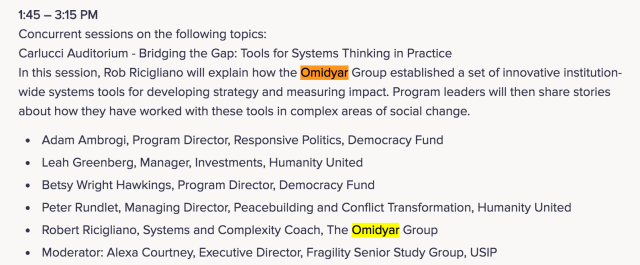
As a USIP consultant, Frontier has also served as the organizing “secretariat” of the “Fragility Study Group,” convened by USIP and the contractor-funded Center for a New American Security (CNAS), which was founded by former Pentagon official Michelle Flournoy and other Democratic hawks.
Best of all for Omidyar, who has managed to maintain his USAID relationships through the Obama and Trump presidencies, Frontier has provided an important link. In 2017 Frontier organized and promoted for USIP a “Passing the Baton” conference billed as “a review, during the transition between administrations, of global challenges confronting our nation.” Its website features a photograph of a happy Stephen Hadley applauding Trump’s incoming (and now disgraced) National Security Adviser Michael Flynn gaily shaking hands with Susan Rice, his hawkish equivalent in the Obama White House.
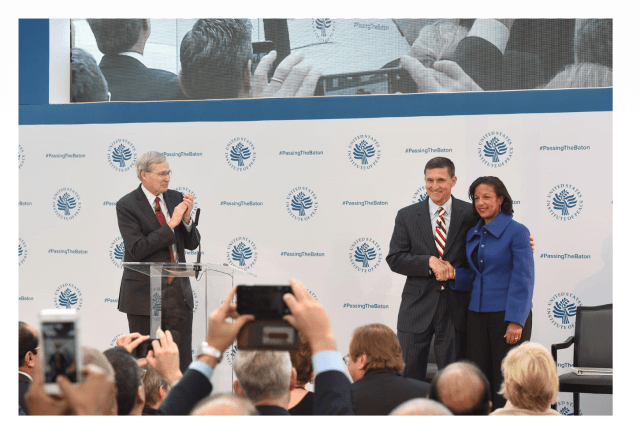
When I looked into Frontier in 2017, I decided there wasn’t enough of a smoking gun to write a story about the relationship between the lefty billionaire and his counterinsurgency consultant. But a month ago, long before the public closure of the Snowden Archives, I learned that Frontier was the sole contractor for a major USAID project to come up with a new counterinsurgency doctrine for the Trump administration. That caught my attention and convinced me to finally do a story.
In a paper first reported by the trade publication Devex, Frontier, led by Courtney, is urging USAID to create “red teams” of aid workers, CIA operatives and US special forces to intervene in global hot spots, such as Venezuela. They would mobilize to scatter US security personnel throughout a country and outside of the cities when political unrest threatens “stability” and American interests. It was commissioned by none other than Omidyar’s friends at USAID’s Global Development Lab, which Devex reported, has hired “the Frontier Design Group to undertake research and development on new approaches to countering violent extremism.”
The report, which can be found on the Frontier and USAID websites, is extraordinary, and has to be read to be believed.
From the Vietnam War to today’s crisis in Syria, the United States Government (USG) has experimented with various expeditionary models for mobilizing its development personnel alongside their military and interagency colleagues to unleash their unique capabilities for stabilization, reconstruction, and counterinsurgency (COIN) missions.
As the lead implementer of development and humanitarian assistance for the USG since 1961, the United States Agency for International Development (USAID) is a key interlocutor for mobilizing civilian personnel in non-permissive environments (NPEs). In a risk-adverse post-Benghazi world, designing and building right-sized capabilities to effectively anticipate, plan for, and respond to crises unfolding across a wide spectrum of contexts is an enormous challenge and one that has frequently bedeviled the USG…
Today, the number of USG civilian personnel focused on COIN and countering violent extremism (CVE) in high-threat environments is extremely limited. It is a profound institutional challenge to get USG civilian personnel with mission-critical skillsets to the contexts and the communities they seek to serve. Ironically, the net effect of limiting access in insecure environments may be making civilian personnel less secure and their critical missions less effective.
Courtney’s report, which USAID told Devex is still under review, is based on interviews with dozens of national security operatives, including former CIA chiefs of station, former USAID mission directors, and “those still serving” as Lieutenant Generals, Colonels, Special Advisors, and more. “These individuals have hard-earned experience in leadership roles in Iraq, Afghanistan, Pakistan, Yemen, Libya, Syria, Philippines, Somalia, the Lake Chad Basin, Venezuela, and Colombia” – basically the entire geography of our endless wars – it states.
Devex reported the gist of the Frontier proposal for USAID’s proposed “non-traditional partners,” which include the CIA:
[They] might include U.S. Marine Corps Forces Special Operations Command, U.S. Army Special Forces, the State Department Bureau of International Narcotics and Law Enforcement Affairs, the Federal Bureau of Investigation, and the Drug Enforcement Administration, according to the study. In order to gauge potential interest in the idea of RED Teams, the study’s authors consulted with representatives from a variety of military and civilian agencies where development officers might be embedded — including the U.S. Naval Special Warfare Development Group, also known as SEAL Team Six.
Wait! The CIA? SEAL Team Six? Aren’t these the targets of The Intercept’s reporting team? Did the founders, especially Scahill, not know that their benefactor had close ties to a contractor advising US Special Forces? I asked, but got no response.
COUNTER-INTELLIGENCE AND THE SNOWDEN DOCUMENTS
Now let me turn to how these connections might have affected Omidyar’s decision to shut down the archive. Here’s one possibility: the Snowden Archives, which include tens of thousands of top-secret documents considered to be stolen property by the NSA, may have become an albatross around the neck of the ambitious Iranian-American billionaire anxious to cash in through his close ties with USAID.
And here’s another: perhaps Omidyar and his wealthy partners in First Look no longer have any use for its secrets because they’ve already tapped into them for intelligence on where to invest their money – kind of an inside trading scheme. After all, Omidyar has literally billions of dollars to invest, and parks his capital in private equity funds, such as the powerful Carlyle Group, which trade in insider information from the former high-ranking government officials they hire as managers and consultants (see this list of the Omidyar Network’s $88 million investments in private equity in 2016, including $149,472 invested in the Carlyle/Riverstone Global Energy and Power Fund).
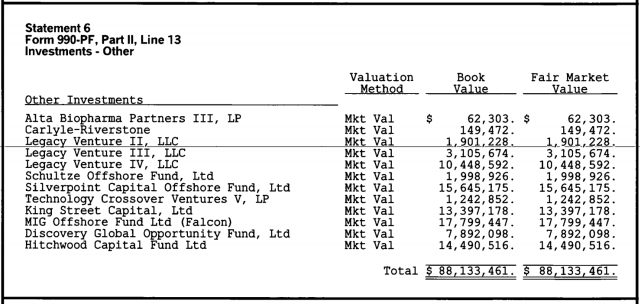
Looking at these possibilities requires some discussion of Omidyar’s overlapping investments and projects at USAID and elsewhere with Jeffrey Skoll, one of his first hires at eBay who himself amassed a fortune of over $3 billion as eBay’s president. Through his eponymous foundation, Skoll owns Participant Media, the Hollywood production company that made Citizen Four, Poitras’s grossly over-hyped and narcissistic cover story (er, documentary) on Edward Snowden. It’s also made dozens of other films – some quite outstanding – that have done exceedingly well at the box office.
Together, Omidyar and Skoll have invested their grant money heavily in every sector of the media, from NPR to ProPublica. They also sunk huge amounts of money into “fact-checking” operations, often in collaboration the Broadcast Board of Governors (BBG), the US government propaganda arm, and the National Endowment for Democracy (NED), which was created by Congress in the 1980s to replace and augment the CIA (The Mint Press recently described these Omidyar projects as “a global cartel of self-styled fact-checking groups that determine which outlets are legitimate and which are fake.”)
Both men were also proud donors to the Clinton Foundation and developed close ties to Hillary Clinton and Barack Obama while they were in office. Skoll alone contributed between $100,000 to $250,000 to the foundation and partnered in “at least” 21 programs through the Clinton Global Initiative, the Associated Press reported in 2016. In 2012, shortly after Skoll met privately with Hillary, according to AP, USAID announced a partnership with his foundation to invest $44.5 million in health, energy, and other sectors around the world (see USAID’s list of projects funded by the foundation). Omidyar and Skoll love this kind of excitement and the rich and famous people who belong to the world of what they call “impact investments.”
In a typical lineup in 2016, they joined William E. McGlashan Jr., a partner with the private equity giant TPG and an early investor in Uber and Airbnb, in a $2 billion “social impact fund” they named “Call Rise.” Among their fellow investors, a star-struck Andrew Ross Sorkin reported in The New York Times, was Bono, the narcissistic rock star, and Richard Branson of Virgin Airways, the flamboyant promoter of the USAID attempted coup at the Venezuelan border. McGlashan called Call Rise “the first global, scale private equity platform directing institutional capital to businesses that measurably address pressing societal challenges.” That’s a good summary of Omidyar’s vision as well: one of his philanthropy’s slogans is “We Believe in Impact, Not Idealism.” (unfortunately, these great liberal minds can be flawed: two weeks ago, McGlashan was accused by the Justice Department of being a key player in an ugly college admission scandal in which he paid $50,000 to have his son’s test scores corrected and create a fake athletic profile for the lad. He has since been fired from TPG.)

Could Omidyar’s and Skoll’s enthusiasm for the government, including deepening involvement with USAID, be threatened by their continued ownership over Snowden’s NSA documents? After all, through The Omidyar Group, Omidyar directly owns The Intercept and its parent company, First Look Media, which have controlled the documents for the past five years. Skoll’s films, including Citizen Four and Zero Days, the Alex Gibney documentary he financed on cybersecurity, also showed that he likely had access to, and some control over, the Snowden documents. If so, these facts would be well known to anyone involved in national security and law enforcement, especially to the Trump administration’s newly aggressive Justice Department.
Only a year ago, for example, Bill Evanina, the director of the National Counterintelligence and Security Center, told AP that, over the previous year, “we had more international, Snowden-related documents and breaches than ever. Since 2013, when Snowden left, there have been thousands of articles around the world with really sensitive stuff that’s been leaked.” He added that less than one percent of Snowden’s documents have been released, “so we don’t see this issue ending anytime soon.” The story quoted Joel Melstad, a spokesperson for the National Counterintelligence Center (which Omidyar’s consultant at Frontier advises) saying that the Snowden documents “have put U.S. personnel or facilities at risk around the world, damaged intelligence collection efforts, exposed tools used to amass intelligence, destabilized U.S. partnerships abroad and exposed U.S. intelligence operations, capabilities and priorities.”
Greenwald and Snowden, through his attorney, take great issue with that, with Greenwald telling AP that there are “thousands upon thousands of documents” that he and other journalists have chosen not to publish because they would harm their reputations and privacy and expose “legitimate surveillance programs.” In his Twitter explanation of the archive’s closure, he also said that “it is worth remembering that Edward Snowden never wanted the full archive of documents to be published; to the contrary, he adamantly insisted…that there will never be a full dumping of the archive.” Still, he and Omidyar both must know that Evanina and the Justice Department could strike at them even if such a prosecution would be widely seen, correctly, as an attack on press freedoms. I have no doubt that Omidyar, with his vast investments with USAID and throughout the world, could fear the implications of any government move against the archives. Closing them down, in that context, would make financial and political sense.
And then there’s all that money sloshing through their foundations. “The Omidyar Group is a very interesting organization,” says a corporate attorney who has investigated complicated business structures and is familiar with some of the players in Omidyar’s and Skoll’s circles. “There’s many questions to start asking about Omidyar’s foundation because, like Skoll’s, they split themselves into a profit entity and a foundation entity, and there’s vast amounts of money – hundreds of millions of dollars – flowing back and forth in ways that can’t be seen by these entities. Plus they employ armies of lawyers and accountants. They’re pretty much run like private intelligence entities.” He’s the one who told me, “they have the resources of small nation-states.”
To Omidyar and Skoll, my source continued, “the real value of information is what you know that other people don’t know.” That’s how inside trading happens, he suggested, “Just look at the holdings of Omidyar and Skoll. If you have access to classified information, its real value is in what you don’t disclose.” About the people who got access to the trove, he asks: “What if it was arbitraged and they were trading in it?” (According to Investopedia, “Arbitrage occurs when a security is purchased in one market and simultaneously sold in another market at a higher price, thus considered to be risk-free profit for the trader.”)
To underscore his point, the attorney pointed me to an intriguing study on “Coups, Corporations and Classified Information” conducted by a group of professors at UC-Berkeley, Harvard, and Stockholm University in 2009. It correlated coups and overthrows organized by the CIA with stock prices of US companies that stood to benefit, and showed that “not only were U.S-supported coups valuable to partially nationalized multinationals, but that asset traders arbitraged supposedly top-secret” information concerning plans to overthrow foreign governments.” (Here’s a list from the paper of US interventions listed by code name, country, and whether the villain in question had expropriated a US company.)
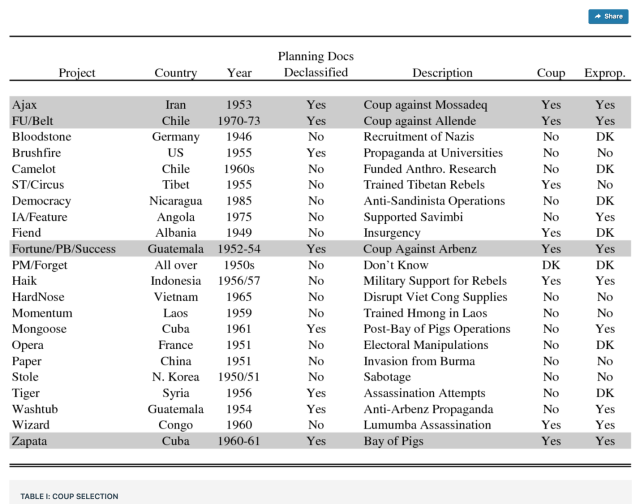
Could Omidyar and Skoll, like corporations during the Cold War, have used top-secret information contained in Snowden’s unreleased documents to help guide their investments around the world with the private equity and hedge funds they use, which are known to trade on such inside information? Why not? That’s what I would do if I was a billionaire capitalist and had unfettered access to classified documents from the NSA. But perhaps the information had become too dated, and therefore was not worth holding onto any longer. Or, with the continued DOJ interest in the Snowden Archive, perhaps the trove just became too dangerous to hold onto.
“You have to protect your equities,” my lawyer source concluded. One way or another, that’s what Omidyar seems to be doing everywhere he goes.
![]()
![]()
![]() Connections in the Media Web of Lies
Connections in the Media Web of Lies
An
Since 9-11 we have seen the pigs behind the conspiracy: the neo-cons, Zionist
I am constantly reminded, of the day I was called into to be spoken at by the new Jewish management of Rossiya Sevodnya after the liquidation of the Voice of Russia and I was told one thing and one thing only: "We are to always be positive or neutral about Israel." Nothing more, nothing about President Putin or even about Russia. Just Israel. The Zionists have taken over.
Now the entire global media is under Zionist control and for those of you left with independent thinking minds remember this and never forget: 9-11 was an inside job, ISIS and Al-Qaeda are US/NATO/CIA secret terrorist armies and the US/NATO/MOSSAD/SUADI are attempting to destroy Russia and China and will do anything to meet their goals, including the murder and genocide of millions.
You will not read about it in the western media but the US
In closing I
John Robles
01-14-2015
Meet Sharon Weinberger: The Intercept’s New “National Security” Editor and Former Dov S. Zakheim Associate
by Scott Creighton SOURCE (H/T tommyknocker1)
A little while ago I wrote about Matt Taibbi leaving the employ of billionaire Pierre Omidyar. Since then I have reported on Matt’s refusal to address his split with Omidyar’s company, First Look Media, which also owns Glenn Greenwald’s limited hangout / propaganda vehicle, the Intercept.
“I can’t, I can’t, I can’t talk about [Omidyar] unfortunately,” “I really shouldn’t comment… No matter what my feelings toward First Look Media, I don’t think it’s appropriate to talk about my former employers.” Matt Taibbi
It’s well known that Omidyar teamed up with the CIA linked USAID and funded a number of regime change NGOs in Ukraine and now he has one of his employees, Svitlana Zalishchuk, a person who headed up many of those color revolution engines, “elected” to office in the country. It should be noted that all that “freedom and democracy” they talked about bringing to Ukraine is ending up with the Ukrainian parliament now instituting legalized slavery on their own people.
In a follow-up article, I mentioned the fact that Omidyar and Greenwald were headed to Google’s Newsgeist conference where they will learn how to mold the future of alternative “news” sites. I also exposed the Omidyar Network’s long history of globalist activity and partnership with the CIA.
Greenwald says that he and Omidyar plan to finally meet later this month, when they will appear at a very different sort of gathering: an invite-only event called Newsgeist, co-sponsored by Google and the Knight Foundation. Billed as an “unconference,” it has no agenda other than “reimagining the future of the news.” Andrew Rice
I also mentioned, that Pierre Omidyar has a new deal in the works with the CIA’s USAID. It’s a 300 million dollar project aimed at mixing Pierre’s personal brand of “charitable aims” with the raw power of the CIA. Nifty, huh? The fund, the Global Innovation Fund, will be headquartered in London of course.
The fund, which will be based in London, is looking for fresh ways to tackling problems that trump existing approaches. Inside Philanthropy
Mr. Omidyar helped spearhead what’s now called “venture philanthropy” by mixing Silicon Valley entrepreneurship with charitable aims. His projects include a $100-million microfinance fund and a just-announced $200-million Global Innovation Fund, established in partnership with the U.S. Agency for International Development. Philanthropy.com
I tell you all of that so I can tell you this: Glenn’s Intercept has a new editor. Her name is Sharon Weinberger and you will not believe the connections this woman has. Anyone who still thinks Greenwald, First Look and the Intercept are “outsiders” is a fool. The Intercept is nothing more than a “hearts and minds” operation disguised as independent media and Omidyar’s hiring of Sharon Weinberger proves that beyond any lingering doubt.
First of all, John Cook is also leaving Omidyar’s little disinformation distribution center. As tommyknocker1 suggested, it’s probable that he doesn’t want any part of what the Rock is Cooking at the Intercept. Another color revolution regime change in the works? Who knows. But Cook the road after less than a year and I wouldn’t expect him to shed any light on his reasoning either.
So, now let’s deal with the Intercept’s new “national security” editor, Weinberger.
And now for some good news! I’d like to welcome Sharon Weinberger to the staff of The Intercept, where she will serve as our national security editor, heading up our investigative reporting on intelligence, military affairs, government surveillance, and the Snowden archive. The Intercept
Remember, the Intercept was supposed to be an independent news agency, an outsider taking on the status quo. Right? Let’s see how that works out with the acquisition of Sharon Weinberger.
Weinberger and Dov S. Zakheim
Back in 2000, Sharon Weinberger teamed up with Dov S. Zakheim to write a policy paper (Toward a Fortress Europe PDF) for a think tank called the Center for Strategic and International Studies . At the time she was a defense analyst for System Planning Corporation (SPC).
For the record, SPC is the largest DARPA contractor working in R&D in fields related to:
Homeland Security
Nuclear, Chemical and Biological Warfare
How about a little background on CSIS :
“conducts policy studies and strategic analyses of political, economic and security issues throughout the world, with a specific focus on issues concerning international relations, trade, technology, finance, energy and geostrategy.”
The board of trustees includes many former senior government officials including Henry Kissinger, Zbigniew Brzezinski, William Cohen, George Argyros and Brent Scowcroft. The board also includes major corporate business leaders as well as prominent figures in the fields of finance, private equity, real estate, academia and media. Wiki
Some might argue that Sharon’s ties to these globalist Military Industrial Complex entities are old and therefore no longer of importance to her. To that I say “bunk”
In an article Sharon wrote for Foreign Policy magazine in Nov. of 2012, she argued that Obama needed to continue funding DARPA to the fullest extent at a time when austerity measures and government shut downs were being inflicted on the nation.
As he enters budget negotiations, here are five things President Obama needs to remember if he doesn’t want to leave a legacy of bayonets.
1) Protect the Defense Advanced Research Projects Agency (and remember that DARPA is an agency, not a slogan).
So clearly she still supports DARPA even in times of dire economic duress. It should also be noted that Foreign Policy magazine is headed by David J. Rothkopf who is is a member of the Council on Foreign Relations and who was managing director of Kissinger Associates. Rothkopf also “was the chairman, CEO, and co-founder of Intellibridge Corporation, a leading provider of international analysis and open-source intelligence for the U.S. national security community and selected investors, financial organizations and other corporations”
Sharon has written a number of articles for Foreign Policy.
For those of you who don’t know who Dov S. Zakheim is:
From 1987-2001, Zakheim was CEO of SPC International, a subsidiary of System Planning Corporation, a high-technology analytical firm….
During the 2000 U.S. Presidential election campaign, Zakheim served as a foreign policy advisor to George W. Bush as part of a group led by Condoleezza Rice that called itself The Vulcans. He was part of the Project for the New American Century…
He was then appointed as Under Secretary of Defense (Comptroller) from 2001 in George W. Bush administration, and served in this capacity until April 2004. During his term as Comptroller, he was tasked to help track down the Pentagon’s 2.3 trillion dollars‘ worth of unaccounted transactions Wiki
Zakheim helped write PNAC’s infamous, Rebuilding America’s Defenses in 2000. That’s the publication written by all those neo-cons that called for “a new Pearl Harbor type event” exactly one year prior to 9/11 so they could implement their plan for an endless war and the remaking of the political system in the United States. Many of those neo-cons were in power when the planes hit the buildings and many of them, including Zakheim, were involved in planning candidate Bush’s foreign policy objectives a year prior to him being “elected” (which we all know he wasn’t)
As you can also see, Donald Rumsfeld (criminal and traitor) appointed Dov to head up the group that was to look into the missing 2.3 trillion dollars that Don announced on Sept. 10th 2001.
As it just so happened, it was Dov’s very offices that were destroyed when something hit the side of the Pentagon. Dov wasn’t there that morning. Many of his staff were killed. Most of the records needed to figure out where that money went were destroyed. Did I mention Dov wasn’t there that day?
While he was helping people like Condi Rice and Dick Cheney figure out Bush’s foreign policy agenda in 2000, he was CEO of SPC. Do you know what SPC had recently developed back then?
In August of 2001, this technology was further demonstrated by Raytheon, which successfully took off and landed a Boeing 727 six times at Holloman AFB in New Mexico without a pilot on board..
Another curious connection presents itself in Dov Zakheim, the comptroller of the Bush Pentagon and, until taking over his Pentagon role in 2001, CEO of SPC International, a subsidiary of Sytstem Planning Corporation, which provides a so-called “Flight Termination System” for the US military that the company boasts provides “a fully redundant turnkey range safety and test system for remote control and flight termination of airborne test vehicles.” James Corbett
That’s right, SPC developed remote piloting systems for jumbo jets and other planes.
The paper crafted by Zakheim and Weinberger is all about how Europe needed to collaborate and consolidate their defense industries and policies. It was written in collaboration with every conceivable MIC CEO you could think of at the time as well as “various US agencies”.
(chapter heading) The Endgame: Pan-European Companies and the Future of Transatlantic Cooperation
(from the forward) …To understand these events, we invited senior corporate executives from both sides of the Atlantic to lead our discussions .These included, in alphabetical order: Gregory Bradford, president and chief operating officer, EADS; Philippe Camus, co-chief executive officer, EADS; William Denk, director, Defense Programs Division, U.S. Department of Commerce; Anthony Ennis, executive vice president, BAE Systems; Jean Fournet, director for cooperation and industrial affairs, DGA/DCI, French Ministry of Defense; Rainer Hertrich, co-chief executive officer, EADS; Bruce Jackson, vice president for strategic planning, Lockheed Martin Corporation; Jean-Luc Lagardère, president, Aérospatiale MATRA; Susan Ludlow-MacMurray, director, International Security Program, Office of the Under Secretary for Policy, U.S. Department of Defense; Bernard Rétat, vice chairman, Thomson-CSF; Christian Shore, director of international policy, Raytheon Company; and Fred Whiteford, director of strategic planning, Boeing Military Aircraft and Missile group. Toward a Fortress Europe
Basically, this is a paper dedicated to the globalization of the Military Industrial Complex and the expansion of NATO. It’s the European counterpart to the Rebuilding America’s Defenses paper.
All in all, the hiring of Sharon Weinberger (Casper Weinberger’s granddaughter?) makes it pretty clear what the Intercept really is, as if those of us who are paying attention needed anymore evidence. I didn’t mean to spend so much time on this article, but once you start digging you have to follow the hole where-ever it leads.
So congrats to First Look and the Intercept: you’ve brought on a MIC shill who’s dedicated to further empowering the very interests you claim to be trying to keep in check and in so doing, hopefully if your readers are paying attention, you’ve exposed your war-mongering billionaire oligarch just a wee bit more.
So much for being independent and adversarial to the globalist’s New World Order.
Cheers.
I can be reached at jar2@jar2.com
Copyright JAR2 2003-2103 All Rights Reserved Publishing Banned Truth Since June 06, 2003




